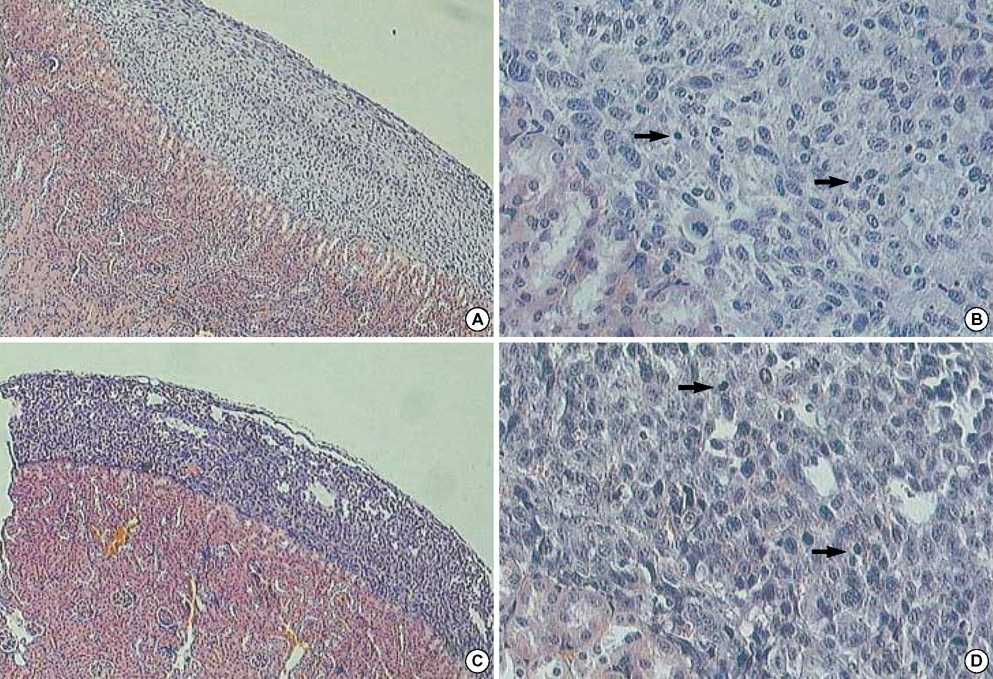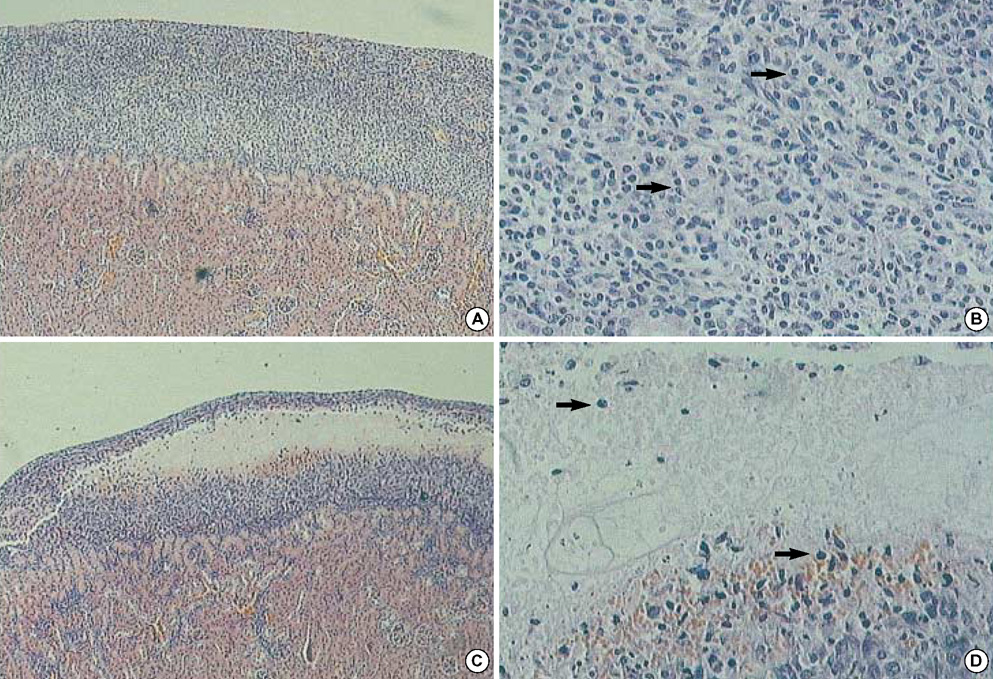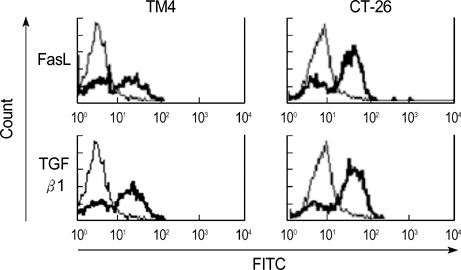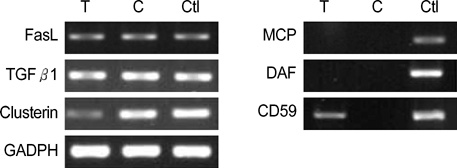J Korean Med Sci.
2007 Apr;22(2):277-282. 10.3346/jkms.2007.22.2.277.
Role of Complement Regulatory Proteins in the Survival of Murine Allo-transplanted Sertoli Cells
- Affiliations
-
- 1Department of Thoracic and Cardiovascular Surgery, College of Medicine, Seoul National University, Seoul, Korea. jrl@plaza.snu.ac.kr
- 2Laboratory of Immunology, Cancer Research Institute, College of Medicine, Seoul National University, Seoul, Korea.
- 3Laboratory of Stem Cell Differentiation, College of Dentistry, Seoul National University, Seoul, Korea.
- 4Xenotransplantation Research Center, Seoul National University, Seoul, Korea.
- KMID: 1713188
- DOI: http://doi.org/10.3346/jkms.2007.22.2.277
Abstract
- Sertoli cells (SC) are known to contain immunoprotective properties, which allow them to survive as allografts without the use of immunosuppressive drugs. Experiments were designed to determine which factors are related to prolonged survival of allogeneic SC. Balb/c derived Sertoli (TM4) and colon cancer (CT-26) cell lines were implanted beneath the kidney capsule of non-immunosuppressed C57BL/6 mice and compared their survival as allografts. Compared to TM4 graft, which survived more than 7 days after transplantation, CT-26 showed massive infiltration of polymorphonuclear cells, necrosis and enlargement of draining lymph nodes. Cultured cell lines showed no differences in their expression patterns of FasL, TGF beta1, clusterin and two complement regulatory proteins (CRP, i.e., membrane cofactor protein, MCP; decay accelerating factor, DAF), but protectin (CD59), another member of CRP was expressed only on TM4. These results suggest that CD59 and unknown factors may contribute to the prolonged survival of SC in non-immunoprivileged sites.
Keyword
MeSH Terms
-
Transplantation, Homologous/immunology
Transforming Growth Factor beta1/*immunology
Sertoli Cells/*immunology/*transplantation
Mice, Inbred C57BL
Mice
Male
Graft Survival/*immunology
Female
Fas Ligand Protein/*immunology
Complement System Proteins/*immunology
Clusterin/*immunology
Cells, Cultured
Cell Survival
Animals
Figure
Cited by 1 articles
-
Mechanism of Humoral and Cellular Immune Modulation Provided by Porcine Sertoli Cells
Hak-Mo Lee, Byoung Chol Oh, Dong-Pyo Lim, Dong-Sup Lee, Hong-Gook Lim, Chun Soo Park, Jeong Ryul Lee
J Korean Med Sci. 2008;23(3):514-520. doi: 10.3346/jkms.2008.23.3.514.
Reference
-
1. Dufour JM, Rajotte RV, Seeberger K, Kin T, Korbutt GS. Long-term survival of neonatal porcine Sertoli cells in non-immunosuppressed rats. Xenotransplantation. 2003. 10:577–586.
Article2. Korbutt GS, Elliott JF, Rajotte RV. Cotransplantation of allogeneic islets with allogeneic testicular cell aggregates allows long-term graft survival without systemic immunosuppression. Diabetes. 1997. 46:317–322.
Article3. Selawry HP, Cameron DF. Sertoli cell-enriched fractions in successful islet cell transplantation. Cell Transplant. 1993. 2:123–129.
Article4. Gores PF, Hayes DH, Copeland MJ, Korbutt GS, Halberstadt C, Kirkpatrick SA, Rajotte RV. Long-term survival of intratesticular porcine islets in nonimmunosuppressed beagles. Transplantation. 2003. 75:613–618.
Article5. Bellgrau D, Gold D, Selawry H, Moore J, Franzusoff A, Duke RC. A role for CD95 ligand in preventing graft rejection. Nature. 1995. 377:630–632.
Article6. Cupp AS, Kim G, Skinner MK. Expression and action of transforming growth factor beta (TGFbeta1, TGFbeta2, and TGFbeta3) during embryonic rat testis development. Biol Reprod. 1999. 60:1304–1313.7. Kang SM, Schneider DB, Lin Z, Hanahan D, Dichek DA, Stock PG, Baekkeskov S. Fas ligand expression in islets of Langerhans does not confer immune privilege and instead targets them for rapid destruction. Nat Med. 1997. 3:738–743.
Article8. Chen JJ, Sun Y, Nabel GJ. Regulation of the proinflammatory effects of Fas ligand (CD95L). Science. 1998. 282:1714–1717.
Article9. Suarez-Pinzon W, Korbutt GS, Power R, Hooton J, Rajotte RV, Rabinovitch A. Testicular sertoli cells protect islet beta-cells from autoimmune destruction in NOD mice by a transforming growth factor-beta1-dependent mechanism. Diabetes. 2000. 49:1810–1818.
Article10. Dufour JM, Rajotte RV, Korbutt GS, Emerich DF. Harnessing the immunomodulatory properties of Sertoli cells to enable xenotransplantation in type I diabetes. Immunol Invest. 2003. 32:275–297.
Article11. Perez de la Lastra JM, Harris CL, Hinchliffe SJ, Holt DS, Rushmore NK, Morgan BP. Pigs express multiple forms of decay-accelerating factor (CD55), all of which contain only three short consensus repeats. J Immunol. 2000. 165:2563–2573.
Article12. Mather JP. Establishment and characterization of two distinct mouse testicular epithelial cell lines. Biol Reprod. 1980. 23:243–252.13. Hooper P, Bora NS, Kaplan HJ, Ferguson TA. Inhibition of lymphocyte proliferation by resident ocular cells. Curr Eye Res. 1991. 10:363–372.
Article14. Ferguson TA, Fletcher S, Herndon J, Griffith TS. Neuropeptides modulate immune deviation induced via the anterior chamber of the eye. J Immunol. 1995. 155:1746–1756.15. Selawry HP, Kotb M, Herrod HG, Lu ZN. Production of a factor, or factors, suppressing IL-2 production and T cell proliferation by Sertoli cell-enriched preparations. A potential role for islet transplantation in an immunologically privileged site. Transplantation. 1991. 52:846–850.16. De Cesaris P, Filippini A, Cervelli C, Riccioli A, Muci S, Starace G, Stefanini M, Ziparo E. Immunosuppressive molecules produced by Sertoli cells cultured in vitro: biological effects on lymphocytes. Biochem Biophys Res Commun. 1992. 186:1639–1646.17. Korbutt GS, Suarez-Pinzon WL, Power RF, Rajotte RV, Rabinovitch A. Testicular Sertoli cells exert both protective and destructive effects on syngeneic islet grafts in non-obese diabetic mice. Diabetologia. 2000. 43:474–480.
Article18. Mogil RJ, Radvanyi L, Gonzalez-Quintial R, Miller R, Mills G, Theofilopoulos AN, Green DR. Fas (CD95) participates in peripheral T cell deletion and associated apoptosis in vivo. Int Immunol. 1995. 7:1451–1458.
Article19. King C, Davies J, Mueller R, Lee MS, Krahl T, Yeung B, O'Connor E, Sarvetnick N. TGF-beta1 alters APC preference, polarizing islet antigen responses toward a Th2 phenotype. Immunity. 1998. 8:601–613.20. Ferguson TA, Griffith TS. A vision of cell death: insights into immune privilege. Immunol Rev. 1997. 156:167–184.
Article21. Thorley BR, Milland J, Christiansen D, Lanteri MB, McInnes B, Moeller I, Rivailler P, Horvat B, Rabourdin-Combe C, Gerlier D, McKenzie IF, Loveland BE. Transgenic expression of a CD46 (membrane cofactor protein) minigene: studies of xenotransplantation and measles virus infection. Eur J Immunol. 1997. 27:726–734.
Article22. Marquet RL, van Overdam K, Boudesteijn EA, Bonthuis F, Kouwenhoven EA, de Bruin RW, Schraa EO, IJzermans JN. Immunobiology of delayed xenograft rejection. Transplant Proc. 1997. 29:955–956.
Article
- Full Text Links
- Actions
-
Cited
- CITED
-
- Close
- Share
- Similar articles
-
- Role of Complement in Bronchial Asthma
- Increase in Transepithelial Resistance Mouse Sertoli Cells by Leydig Cells Coculture
- Effect of Growth Hormone on Death of Sertoli Cell
- The Effect of Intravenous Immunoglobulin on Hyperacute and Acclerated Rejection in Heart Transplantation of the Rat
- Alternative and Complement Therapies for Asthma





